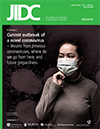QuEChER method for air microbiological monitoring in hospital environments
DOI:
https://doi.org/10.3855/jidc.11563Keywords:
hospital aerobiology, QuEChER, PM2.5, CO2, microbial loadAbstract
Introduction: Nosocomial pathogens have become a priority issue for public health, since they are responsible for increased morbidity and mortality in hospitalized patients and the development of multi-resistant microorganisms, as well. Recent studies found strong evidence that airborne transmission plays a key role in many nosocomial infections. Thus, we aim to develop a QuEChER methodology for the characterization of airborne microbial levels, analyzing potential variables that modify the air microbiological load.
Methodology: Particulate matter levels and suspended and settled bioaerosols were determined simultaneously employing optical sensors, Harvard impactors and settle plates, respectively. Environmental variables were also measured at different sites during different working shifts and seasons.
Results: We found a straightforward relationship between airborne particles, air exchange rates, and people influx. Levels of suspended microorganisms were related to fine particulate matter concentration, CO2 and ambient temperature. A positive linear relationship (R2 = 0.9356) was also found between fine particulate matter and CO2 levels and air microbial load.
Conclusion: The QuEChER methodology is an effective methodology that could be used to improve the surveillance of nosocomial pathogens in developing countries hospitals where air quality is scarcely controlled.
Downloads
Published
How to Cite
Issue
Section
License
Authors who publish with this journal agree to the following terms:
- Authors retain copyright and grant the journal right of first publication with the work simultaneously licensed under a Creative Commons Attribution License that allows others to share the work with an acknowledgement of the work's authorship and initial publication in this journal.
- Authors are able to enter into separate, additional contractual arrangements for the non-exclusive distribution of the journal's published version of the work (e.g., post it to an institutional repository or publish it in a book), with an acknowledgement of its initial publication in this journal.
- Authors are permitted and encouraged to post their work online (e.g., in institutional repositories or on their website) prior to and during the submission process, as it can lead to productive exchanges, as well as earlier and greater citation of published work (See The Effect of Open Access).








